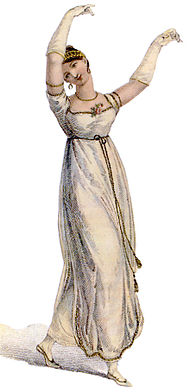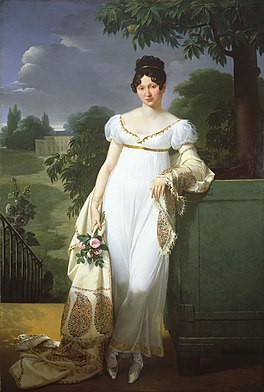44:
61:
32:
234:). The change is probably partially due to the French political upheavals after 1789 (which encouraged the recovery of ancient virtues, and discouraged the type of ostentatious ornately luxurious display formerly common in aristocratic fashions). The early styles often featured entirely bare arms, as in the ancient exemplars, but from about 1800 short sleeves became more typical, initially sometimes transparent as in
456:
268:, who designed such garments for her performances of poses in imitation of classical antiquity ("attitudes"), which were a sensation throughout Europe. The high-waisted cut of the dress was also applied to outer garments, such as the pelisse. The Empire silhouette contributed to making clothes of the
263:
as French styles, even when the countries were at war. The style was very often worn in white to denote a high social status (especially in its earlier years); only women solidly belonging to what in
England was known as the "genteel" classes could afford to wear the pale, easily soiled garments of
202:
Empire dresses were light and loose, usually white, and were often made with short sleeves. A tie around the waistline, sitting just below the bust, was often in a different color. A long rectangular shawl or wrap, very often red with a decorative border in portraits, was also worn, and was lain
203:
around the midriff when seated—for which sprawling semi-recumbent postures were favored. By the turn of the 19th century, such styles had spread widely across Europe. In France the style was sometimes called "à la grecque" after the decorations found on the pottery and sculpture of
194:
had held a "Greek supper" where the ladies wore plain white "Greek" tunics. Shorter classical hairstyles, where possible with curls, were less controversial and very widely adopted. Hair was now uncovered even outdoors; except for evening dress,
190:
The last few years of the 18th century first saw the style coming into fashion in
Western and Central Europe (and European-influenced areas). In 1788, just before the Revolution, the court portraitist
117:
While the style goes back to the late 18th century, the term "Empire silhouette" arose over a century later in early 20th-century
Britain; here the word
199:
or other coverings had typically been worn even indoors before. Thin Greek-style ribbons or fillets were used to tie or decorate the hair instead.
275:
The 1960s saw a revival of the style, possibly reflecting the less strict social mores of the era, similar to when the unconstricting 1920s "
388:"The Little White Dress: Politics and Polyvalence in Revolutionary France" in: Fashion Theory. The Journal of Dress, Body and Culture, 19:5
129:
was influential in popularizing the style around Europe. The word "empire" is pronounced with a special quasi-French pronunciation
114:
wishing to disguise the stomach area or emphasize the bust. The shape of the dress also helps to lengthen the body's appearance.
425:
226:
The adoption of this style led to a drastic contrast between 1790s fashions and the constricting and voluminous styles of the
219:
used the dress in an imperial context, shifting its meaning from Greece to Rome in line with his political agenda during the
521:
215:, a simple white gown influenced by those worn by European women living abroad in warm climates, including the Americas.
191:
460:
187:, which were belted under the bust, providing support and a cool, comfortable outfit suitable for the warm climate.
43:
297:
292:
272:
generally less confining and cumbersome than high-fashion clothes of the earlier 18th and later 19th centuries.
434:
240:
516:
511:
20:
506:
126:
60:
269:
227:
252:, becoming gradually less simple, after which the hourglass Victorian styles became more popular.
401:
53:
or similar wrap, or a short "Spencer" jacket, as the dresses were light and left much uncovered.
501:
496:
491:
486:
481:
476:
106:
which is long and loosely fitting but skims the body rather than being supported by voluminous
69:
260:
164:
65:
8:
317:
312:
265:
235:
204:
122:
406:
327:
307:
231:
430:
196:
111:
352:
302:
249:
208:
183:
132:
256:
73:
245:
470:
220:
442:
The Little White Dress: Politics and
Polyvalence in Revolutionary France”
168:
444:
in: Fashion Theory. The
Journal of Dress, Body and Culture, 19:5, 2015
356:
107:
31:
216:
426:
The Age of
Napoleon: Costume from Revolution to Empire, 1789–1815
276:
455:
322:
280:
177:
99:
95:
147:
172:
135:
103:
50:
207:, though the empire dress had multiple sources, including
49:
French lady in 1808; the style was often accompanied by a
171:
art which showed women wearing loose fitting rectangular
94:
is a style in clothing in which the dress has a fitted
16:
Woman's dress style with a high waist and narrow skirt
144:
244:(1800), then puffed. The style evolved through the
141:
138:
102:, giving a high-waisted appearance, and a gathered
19:"Empire line" redirects here. For other uses, see
468:
264:the era. The look was popularized in Britain by
255:English women's styles (often referred to as "
259:") followed the same general trend of raised
402:Pretty Words, Jane; Would That You Were Too
110:. The outline is especially flattering to
59:
385:
469:
230:(with a rigid cylindrical torso above
125:(1804–1815); Napoleon's first Empress
429:, Metropolitan Museum of Art, 1989.
13:
417:
14:
533:
448:
454:
131:
42:
30:
394:
379:
370:
361:
345:
192:Louise Élisabeth Vigée Le Brun
1:
333:
298:1795–1820 in Western fashion
293:1750–1795 in Western fashion
279:" styles replaced the heavy
121:refers to the period of the
7:
286:
241:Portrait of Madame Récamier
163:The style began as part of
10:
540:
158:
18:
72:(1806) with Empire waist
522:Joséphine de Beauharnais
127:Joséphine de Beauharnais
386:Lubrich, Naomi (2015).
167:, reviving styles from
37:Evening gown, from 1811
155:in the fashion world.
98:ending just below the
76:
70:Jean-Bernard Duvivier
63:
463:at Wikimedia Commons
423:Bourhis, Katell le:
283:of the early 1900s.
165:Neoclassical fashion
517:First French Empire
512:History of clothing
318:High-rise (fashion)
313:Emma, Lady Hamilton
266:Emma, Lady Hamilton
205:Classical Greek art
181:or the more common
123:First French Empire
507:Fashion aesthetics
407:The New York Times
328:Spencer (clothing)
308:Corset controversy
213:chemise à la reine
77:
461:Empire silhouette
459:Media related to
400:Charles McGrath,
376:Hunt, pp. 244–245
80:Empire silhouette
529:
458:
440:Naomi Lubrich: “
411:
410:, April 1, 2007.
398:
392:
391:
383:
377:
374:
368:
365:
359:
351:Nellis, Cynthia
349:
270:1795–1820 period
248:until the early
209:Marie Antoinette
154:
153:
150:
149:
146:
143:
140:
137:
46:
34:
539:
538:
532:
531:
530:
528:
527:
526:
467:
466:
451:
420:
418:Further reading
415:
414:
399:
395:
384:
380:
375:
371:
366:
362:
350:
346:
336:
289:
161:
134:
130:
74:Brooklyn Museum
66:Thérésa Tallien
58:
57:
56:
55:
54:
47:
39:
38:
35:
24:
17:
12:
11:
5:
537:
536:
525:
524:
519:
514:
509:
504:
499:
494:
489:
484:
479:
465:
464:
450:
449:External links
447:
446:
445:
438:
419:
416:
413:
412:
393:
378:
369:
360:
343:
342:
335:
332:
331:
330:
325:
320:
315:
310:
305:
300:
295:
288:
285:
246:Napoleonic era
160:
157:
48:
41:
40:
36:
29:
28:
27:
26:
25:
15:
9:
6:
4:
3:
2:
535:
534:
523:
520:
518:
515:
513:
510:
508:
505:
503:
502:1970s fashion
500:
498:
497:1960s fashion
495:
493:
492:1810s fashion
490:
488:
487:1800s fashion
485:
483:
482:1790s fashion
480:
478:
477:1780s fashion
475:
474:
472:
462:
457:
453:
452:
443:
439:
436:
432:
428:
427:
422:
421:
409:
408:
403:
397:
389:
382:
373:
364:
358:
354:
348:
344:
341:
340:
329:
326:
324:
321:
319:
316:
314:
311:
309:
306:
304:
301:
299:
296:
294:
291:
290:
284:
282:
278:
273:
271:
267:
262:
258:
253:
251:
247:
243:
242:
237:
233:
229:
224:
222:
218:
214:
210:
206:
200:
198:
193:
188:
186:
185:
180:
179:
174:
170:
166:
156:
152:
128:
124:
120:
115:
113:
109:
105:
101:
97:
93:
89:
85:
81:
75:
71:
67:
62:
52:
45:
33:
22:
441:
424:
405:
396:
387:
381:
372:
363:
347:
338:
337:
274:
254:
239:
225:
212:
201:
189:
182:
176:
162:
118:
116:
112:apple shapes
91:
88:Empire waist
87:
83:
79:
78:
64:Portrait of
175:, known as
169:Greco-Roman
84:Empire line
21:Empire Line
471:Categories
435:0870995707
334:References
261:waistlines
108:petticoats
367:Hunt, 244
357:About.com
353:"Empire"
287:See also
281:corsetry
232:panniers
223:period.
217:Napoleon
90:or just
277:flapper
257:regency
197:bonnets
159:History
433:
323:Peplos
303:Chiton
221:Empire
184:chiton
178:peplos
173:tunics
119:empire
96:bodice
92:Empire
339:Notes
250:1820s
236:David
228:1770s
104:skirt
51:shawl
431:ISBN
100:bust
355:on
238:'s
211:'s
148:ɪər
68:by
473::
404:,
136:ɑː
86:,
82:,
437:.
390:.
151:/
145:p
142:ˈ
139:m
133:/
23:.
Text is available under the Creative Commons Attribution-ShareAlike License. Additional terms may apply.


